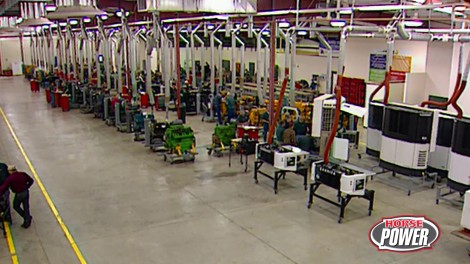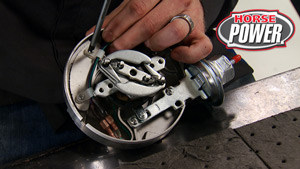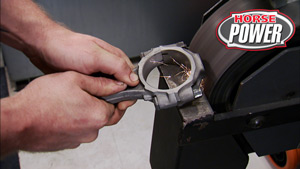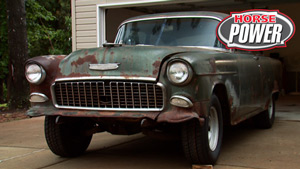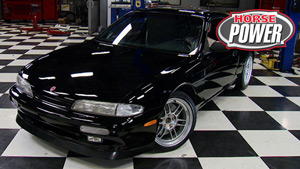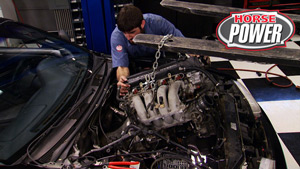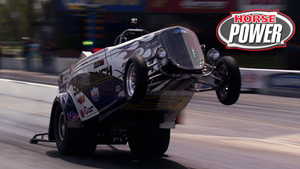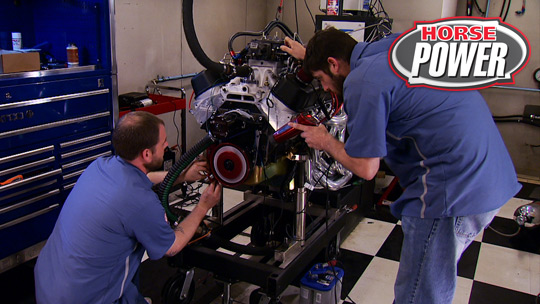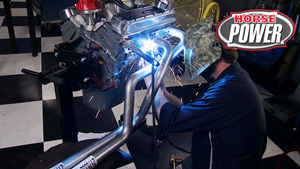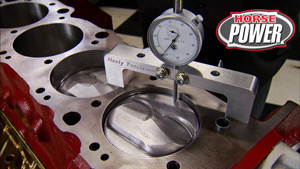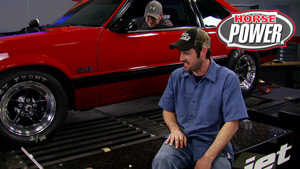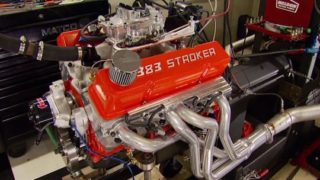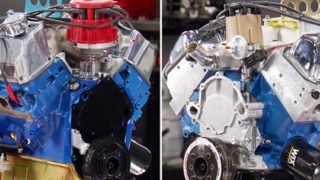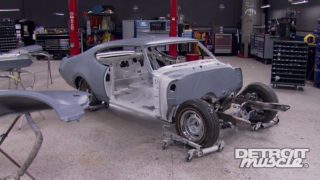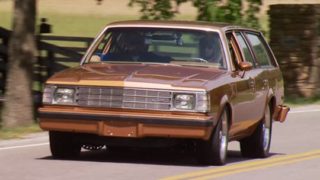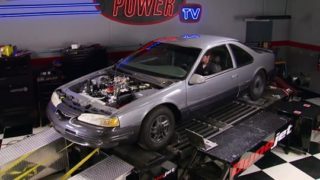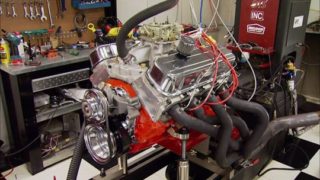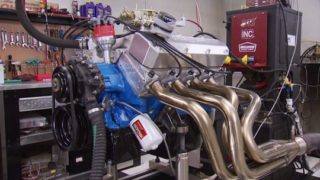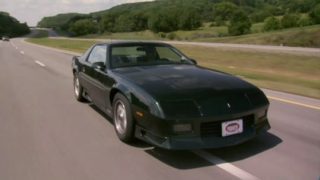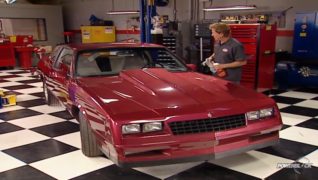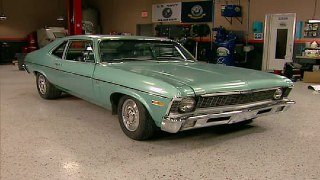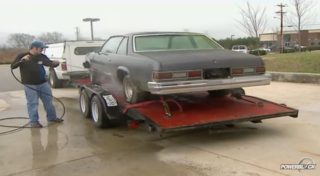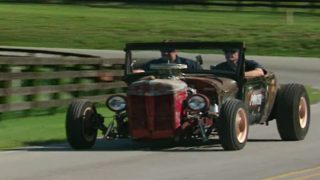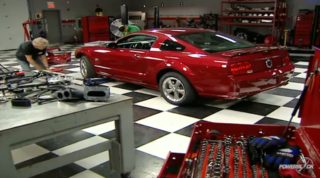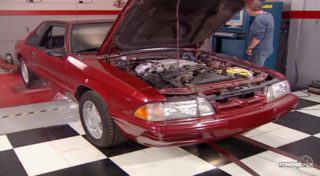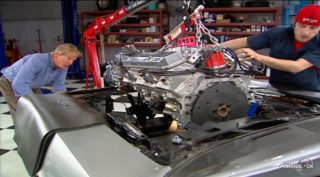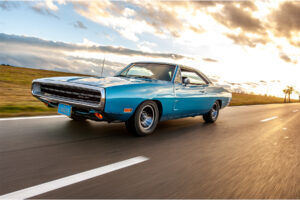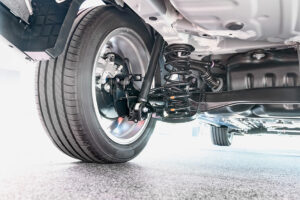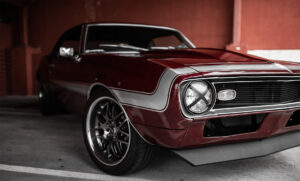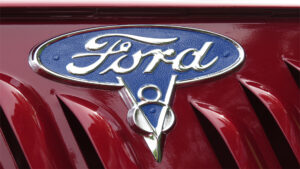HorsePower Builds
Want more content like this?
Join the PowerNation Email NewsletterVideo Transcript
I am Joe Elmore. I want you to join me for a special behind the scenes horsepower adventure on this weekend's show
right now
today on Horsepower TV.
Chances are if it's got high performance manifolds and heads, it came from here. We'll take you to California for a fascinating behind the scenes. Look at high performance parts in the making from the boundary through machining on the final testing on the dyno.
Plus you'll follow an aspiring gearhead in training for a day to see what it takes to earn a degree in high performance here in the 21st century.
So hang on for horsepower TV.
Hi, welcome to the horsepower shop. Well, Chuck, still taking time off for good behavior.
But this weekend, I thought you and I would take off on a couple of road trips.
You know, you've seen us both on all kinds of intake manifolds and heads in the name of making more power. In fact, this 94 Mustang of mine is a candidate for both in the near future.
But there's a fascinating story behind the creation of these power parts too.
In fact, it's a success story that goes back to the earliest chapters of American hot rod history.
It wasn't long after the first automobiles hit America's roads that enthusiasts were pushing them to the limits all in the name of speed and power.
Well, flash forward 40 years or so to the end of World War two
when the country's passion for high performance, first hit high gear
from city back streets to the dry lights of California
and on to the sanction tracks where a young mechanic named Vic
Edelbrock senior was breaking records in his fame. Number 27 midget racer,
Vic Senior personified the work ethic and drive
that made America so great back then,
a vision for success that today and always is made in America.
I follow my father's footsteps where he would look somebody straight in the eye and say, listen, I'm giving you the same product that I would run on my race car. Well, now I'm on a beach anyway.
Uh uh because I know it's the best and I know it works and all that. And we do the same thing today.
After his father's untimely death, Vick Junior helped grow the Edel Rock business into a powerful publicly traded industry
leading the way in the design and development of some of the world's pre eminent high performance parts.
His father's first offering was a manifold for the Ford flathead,
but today Edelbrock has a parts line that includes everything from high performance heads to exhaust systems
just about everything in between.
Yet the manifold is still one of the cornerstones. And to follow one in the making is to follow a true, made in America story that just might make you proud.
A lot of the technology that's in this manhole
here
uh comes from our, our participation in racing, NASCAR and N hr
and
things we learned there, we're able to bring down
to this level and help our performance uh for the area that we needed in
VIC gets a lot of his ideas for new products by getting out there among the enthusiasts of America
and even competing along with his daughters in vintage racing events around the country.
But more about that later
now bringing ideas to reality involves R and D
and that means countless hours of time using pro engineer software
before it goes into production. Though a part can't be just good.
It's gotta be great. Everybody else has got ours to test against and uh we have to keep making it better.
And fortunately, we've been able to do that as time has gone on
once it's good enough for a blueprint, which is also computer generated for accuracy. These days, the new manifold can move on to the pattern shop.
And then finally to the foundry,
er
Brock began casting its own manifolds heads and water pumps in 1988 to ensure quality control throughout the whole process,
a process where technology has refined the time tested science of sand casting
here, specially treated sand is gravity fed into an iron core box.
Any time there's an internal passage in any part where you gotta start with one of these cores,
there's an average of 4 to 5 per casting. Joe. This is
the core that makes the water passage for the uh cylinder head.
And this is a key item because it's very intricate
when our pattern makers make this. They've got to figure out when we change the port location or whatever, make it a little bigger.
They got to make a core box
that'll make this core and get it all done. So water will circulate through the head,
get the proper
picture
and the whole nine yards,
then it's off to the molding line where the cores come together in two halves, each filled with molten aluminum heated to just the right temperature to make a manifold that makes the great
it, it's a tremendous process. A tremendous amount of knowledge goes into it.
If you don't get a good casting
and that isn't porous or has uh uh
holes in it or whatever, then
if you do get that kind of casting, then you've got nothing
about 19 minutes later, our manifold arrives at the shakeout station
where casting and sand are knocked away.
Then it goes through a five hour aging process at high temperatures before it's deferred and ready for shipment to the main facility in Torrance, California.
So as you can see, it takes a lot of craftsmanship and technology to go from a raw aluminum engine like this
to one of these freshly cast manifolds. But
the story is far from finished.
We'll show you the rest when we come back.
The Americans here have one thing in our industry and that's the greater love affair of their automobile, the American greater love affair of the automobile.
And uh that will continue for a long, long, long time and
we plan to be right in the middle of that.
Welcome back to more of our American made intake manifold in the making.
After it leaves the foundry, the new part comes here to the factory where more than 40 CNC machines are available to crank out heads, water pumps and manifolds.
This facility has earned a world recognized QS 9000 certification.
That's what kind of separates the men from the boys a little bit. OK.
Vic Edelbrock took me for a tour of intake manifold central where more types of performance manifolds are machine than anywhere else in the world.
So this is where all that stuff gets machine look pretty,
make sure it fits.
These are the machines that cut the pork surface down here, which
actually the, it's the first operation on an intake manifold. And it's one of the most important because of the way you
the amount of metal you take off that surface
is how the ports are gonna line up
when it holds on.
This particular manifold is mainly machine in there.
All one full swoop and all these surfaces and everything.
They're all done.
Both. They all holes, everything.
Although computer controlled machines ensure speed, consistency and close tolerances.
It's also the handiwork that sets Edelbrock apart from the competitors.
She has just cut all these drilled all these holes
and she drilled all these holes and then she's out, burying them, burying the top.
How are you today?
Good, good
for Edelbrock to keep its certification and aggressive quality control system has to be in place.
Now, the QC guys are always putting parts to the test
in this case, checking for a consistent deck height when we get all through and we know that thing is dead on, it's gonna fit and do the job, right.
That's what's important
before, during and after production. Dyno
testing is essential to see how a manifold or any part behaves in all kinds of situations
and to find that little bit of extra power. If possible,
you have to test it,
you have to test it. There's just no way that the theories are not capable
of telling us if we're gonna get a one or two horsepower game.
So we have to go to the dyno
to test
this. Is it the end of line and it's all done.
Do we inspect them?
We clean them very thoroughly, clean all the holes out
and then Joe Z
goes into a box and
away. It goes.
Well, chances are, you know, there's a third generation of Edel
rocks on the job. Now,
Cammy and sister Christie both race on the Edelbrock Fun team and work for their dad.
Cammy serves as company vice president
and believes it's her job to stay in touch with the newest in manifold technology. This is a pro flow fuel injection system for a small block for.
And what's so neat about our kids is that this manifold assembly comes fully assembled from the factory, pressure tested ready to go
and it has 1000 CFM air valve.
It has the fuel rails, aluminum fuel rails
and the PICO fuel injectors
and everything ready to go, ready to bolt right on your engine. All right. You know a lot about this stuff for a girl. Well, I try,
yeah, I try, I have a good teacher,
my dad,
it's gotta be a good feeling to be the leader in designing high performance manifolds and other parts
to cast them in one of the country's most state of the science foundries
to have a family of dedicated skilled workers along with the finest CNC machining tools.
All this backed by a performance legacy and years of valuable experience,
but there's no time to rest on Laurels here, especially when the imitators are out to cash in on your investment of time, money and hard work
imitations of this equipment in America have been going on for a long time
back in my dad's days. But when imitations are made
and they go offshore and they come back with something that's a look alike, uh, at a very lower price because of $5 a day labor. Then I don't think that's fair.
But, uh, my way of fighting it is to make my name as strong as possible.
If nothing else though, I think we have an advantage
in that. Uh, we have all the experience behind us. We've got a well equipped staff, we have all the facilities.
Um We can do things others maybe can't.
I'm an American. I love being here. I will always make my product here and I'll always be very proud to put that made in the USA right on that product.
Welcome back to the horsepower shop.
If you work on cars for fun or even for a living, chances are you learned your skills from your dad, your friends, even the school of hard knocks and skin knuckles.
Well, today, a lot of career minded guys and gals are getting their training
at
schools now. Some like wild tech even offer programs and street rods and high performance engines.
So right now we're gonna go back to school for a while ourselves to see what a day in the life is like for a gearhead in training.
I came out here mostly to biotech just because of the high performance engines.
Uh with the racing. I was really,
I really got into it and being around the local dirt tracks, circle tracks and stuff like that.
And then, you know, just the engines and chassis and
race cars all in general and
the diesel, the core program was just one I just picked on just,
just because the diesel, I don't know. Just, I thought it was the better way to go for me. Personally.
Nick
Kth came here all the way from Ventura Iowa with a love of engines and a dream of putting his fashion to work someday.
His typical day in the diesel shop at wild
check starts bright and early. It's a long day but it, it, they base it so that
it's like you're in the job in the work field, like it's a normal job. What's next?
Corn
cake
and just like on a normal job, Nick gets his hands dirty, working with all kinds of state of the industry. Hardware.
The main ones are cummins cat in Detroit
and uh
many different series and models. So,
I mean, that's also a plus. I mean, you work on from five speeds to uh 15 speed transmission. So you break onto those uh through uh
single Ds,
three way diss and three drives differentials.
We do a lot of diagnostic testing, hooking up computers, PC US and data links to see what, what was wrong with the engine.
Kids like Nick have great dedication. They're here first thing in the morning they have perfect attendance
and if they're willing to put forth the effort
and give it 100% they'll get more than enough knowledge to be successful in the industry.
I believe it's a good, good course to take. I mean, because you get, you touch base on everything.
Diesel is a pretty intensive six month program in itself. But like a lot of wild tech students,
Nick's not stopping here. In fact,
let's flash forward a few months.
Well, here's where NX is now pursuing his biggest dream in a supercharged three month program where you get to work with high performance engines and fabricate all kinds of cool chassis
on that very, very,
as far as Nick, what he can learn is a lot of broad based uh
different things just besides just welding and cutting metal, he gets to use a lot of tools that he's gonna see in the industry out there.
All right. So what we have now is just three passes around the perimeter even though it's not looking like much. Now, you have to remember we started with a flat piece of metal
and we can see how much contour the panel is already taking on.
We can see down here where originally on a stock 54 Ford, there was a cut out where the spare tire actually used to sit on this panel. I fabricated a replacement for that. Well,
on the Po
Max machine. And as you can see, I've tig welded it in and actually uh created as much of the metal finished uh product as I could to make it virtually invisible from the top side
around here. We do a lot of stuff with chassis work. A lot of uh rear end, front end, uh two chassis,
we do all the suspension, the modifications of the chassis,
uh along with that, we also go with the high performance engines and uh
that's, that's where the funds are right there, building the engines, you know, that,
that push these mean cars when they're all finished and stuff like that.
Of course, it doesn't hard to have renowned engine builders and street by designers like Boyd Cottington lecture and offer some one on one coaching along the way. Like for example, on the door gaps here,
I always use like a paint stick, like a stir stick as a, as a gauge and just kind of use that to,
you know, fit the whole thing and get that nice and even, and then you get, get a fitting out in front and you can fit it in the back
and make to work out real well.
But if you remember
the, the more work you do in this stage of it when you're chopping and fitness, that's the less work you're gonna have to do as you get towards the end of it
to Nick Court. The end result here would be a high paying job in the diesel industry, although he's also on track for a green job, offering his talents to a top notch race team.
Five or 10 years from now.
It'd be nice to see me, uh, living down in the south. Um,
Joe Gibbs racing, Dale Earnhardt in corporate,
uh, somewhere down Hendrix Motorsports. One of those three would be great in 10 years. That, that'd be awesome.
You hope you get an orange one this time.
Hey, what's up?
That's my last quarter.
Oh, well, you know how it goes. Sometimes things never go the way you plan.
Even when you're doing a high performance. How to show.
I think, you know where we're going with this
backed by unpopular demand. More of those madcap mishaps. We call horsepower bloopers.
Now so far we've added a cat back, exhaust a throttle body. And uh what else was that, Chuck?
I
will,
I'm
trying
to remember my lines. You want me to remember yours too? This is a
all right. Well,
I'd say we wouldn't make,
I'm sorry, I'll do it.
I'll do it.
Yeah.
Ok, man. Straighten up.
Oh
huh.
Well, we got about 100 and 84 horsepower, almost 20 more than our baseline.
But you gotta remember. Now, these are rear wheel horsepower. So they're real horses,
you know. Oh,
those, all of them.
What about, what else you wanna tell me?
Hey, bring that thing in here, Joe.
Now, chances are you might have already seen our little budget Honda build up on the show.
That's joke. Burning them gears. I'm sorry.
Yeah,
I don't know, man, you
well keeping your cool. Just got a whole lot easier.
How,
how did it get easier?
No matter what your space limitations are?
You're not rolling, are you?
Of
course, the kit cost us about 550 bucks or just a little bit more than six horses. A piece of plenty. And I
b
uh,
I know you are
cut that thing up. Let me get my,
get my stuff together here.
Horsepower TV S
hot parts is brought to you by Wyotech.
The nation's premier technical training school.
If you're running a T five transmission with a performance clutch in your 84 to 93 mustang,
it's a little hot part from Jegs you might be interested in.
It's a heavy duty front bearing retainer with a steel throw out bearing surface that's more durable than OE, but it has a main body made of aluminum for lightweight.
It's got a price that's pretty lightweight too at just under $42.
Now, if you've got a car with more than a few miles on it, like my mustang here, you might consider some of this valve
max life engine oil. Now, this stuff conditions, the seals to prevent leaks, it reduces oil consumption and even helps you with those cold engine starts.
Oh, you can also use it in new or rebuilt motors
if you've got a Harley Davidson in your driveway or at least one in your heart. Here's a book you could bury your nose in for hours. It's called The Best of Harley Davidson by Peter Henshaw.
And it's loaded with history and beautiful pictures of America's favorite bike from the early days of the V Twin
and way beyond now, it comes from Stoger publishing, which also has this Henshaw book, Classic Bikes, chronicling the whole history of motorcycles in America and the whole world for that matter.
Now, both of these books are available at your favorite bookstore and each cost about 15 bucks.
Well, that's it for hot parts. Here's a look at next week's show
ready for some high performance mobile entertainment. We'll show you how to install a cool yet affordable sound system in your street machine.
And if that's not enough, we'll take you to the wildest indoor car show ever. It's a Florida Festival of wow, sounds and sights and
well, more signs.
Plus we'll show you how to graphically change the personality of your ride with a kit you use at home
for information about the products used in today's show and more. Check us out online at Horsepower tv.com
Horsepower TV is an RTM production.
Show Full Transcript
right now
today on Horsepower TV.
Chances are if it's got high performance manifolds and heads, it came from here. We'll take you to California for a fascinating behind the scenes. Look at high performance parts in the making from the boundary through machining on the final testing on the dyno.
Plus you'll follow an aspiring gearhead in training for a day to see what it takes to earn a degree in high performance here in the 21st century.
So hang on for horsepower TV.
Hi, welcome to the horsepower shop. Well, Chuck, still taking time off for good behavior.
But this weekend, I thought you and I would take off on a couple of road trips.
You know, you've seen us both on all kinds of intake manifolds and heads in the name of making more power. In fact, this 94 Mustang of mine is a candidate for both in the near future.
But there's a fascinating story behind the creation of these power parts too.
In fact, it's a success story that goes back to the earliest chapters of American hot rod history.
It wasn't long after the first automobiles hit America's roads that enthusiasts were pushing them to the limits all in the name of speed and power.
Well, flash forward 40 years or so to the end of World War two
when the country's passion for high performance, first hit high gear
from city back streets to the dry lights of California
and on to the sanction tracks where a young mechanic named Vic
Edelbrock senior was breaking records in his fame. Number 27 midget racer,
Vic Senior personified the work ethic and drive
that made America so great back then,
a vision for success that today and always is made in America.
I follow my father's footsteps where he would look somebody straight in the eye and say, listen, I'm giving you the same product that I would run on my race car. Well, now I'm on a beach anyway.
Uh uh because I know it's the best and I know it works and all that. And we do the same thing today.
After his father's untimely death, Vick Junior helped grow the Edel Rock business into a powerful publicly traded industry
leading the way in the design and development of some of the world's pre eminent high performance parts.
His father's first offering was a manifold for the Ford flathead,
but today Edelbrock has a parts line that includes everything from high performance heads to exhaust systems
just about everything in between.
Yet the manifold is still one of the cornerstones. And to follow one in the making is to follow a true, made in America story that just might make you proud.
A lot of the technology that's in this manhole
here
uh comes from our, our participation in racing, NASCAR and N hr
and
things we learned there, we're able to bring down
to this level and help our performance uh for the area that we needed in
VIC gets a lot of his ideas for new products by getting out there among the enthusiasts of America
and even competing along with his daughters in vintage racing events around the country.
But more about that later
now bringing ideas to reality involves R and D
and that means countless hours of time using pro engineer software
before it goes into production. Though a part can't be just good.
It's gotta be great. Everybody else has got ours to test against and uh we have to keep making it better.
And fortunately, we've been able to do that as time has gone on
once it's good enough for a blueprint, which is also computer generated for accuracy. These days, the new manifold can move on to the pattern shop.
And then finally to the foundry,
er
Brock began casting its own manifolds heads and water pumps in 1988 to ensure quality control throughout the whole process,
a process where technology has refined the time tested science of sand casting
here, specially treated sand is gravity fed into an iron core box.
Any time there's an internal passage in any part where you gotta start with one of these cores,
there's an average of 4 to 5 per casting. Joe. This is
the core that makes the water passage for the uh cylinder head.
And this is a key item because it's very intricate
when our pattern makers make this. They've got to figure out when we change the port location or whatever, make it a little bigger.
They got to make a core box
that'll make this core and get it all done. So water will circulate through the head,
get the proper
picture
and the whole nine yards,
then it's off to the molding line where the cores come together in two halves, each filled with molten aluminum heated to just the right temperature to make a manifold that makes the great
it, it's a tremendous process. A tremendous amount of knowledge goes into it.
If you don't get a good casting
and that isn't porous or has uh uh
holes in it or whatever, then
if you do get that kind of casting, then you've got nothing
about 19 minutes later, our manifold arrives at the shakeout station
where casting and sand are knocked away.
Then it goes through a five hour aging process at high temperatures before it's deferred and ready for shipment to the main facility in Torrance, California.
So as you can see, it takes a lot of craftsmanship and technology to go from a raw aluminum engine like this
to one of these freshly cast manifolds. But
the story is far from finished.
We'll show you the rest when we come back.
The Americans here have one thing in our industry and that's the greater love affair of their automobile, the American greater love affair of the automobile.
And uh that will continue for a long, long, long time and
we plan to be right in the middle of that.
Welcome back to more of our American made intake manifold in the making.
After it leaves the foundry, the new part comes here to the factory where more than 40 CNC machines are available to crank out heads, water pumps and manifolds.
This facility has earned a world recognized QS 9000 certification.
That's what kind of separates the men from the boys a little bit. OK.
Vic Edelbrock took me for a tour of intake manifold central where more types of performance manifolds are machine than anywhere else in the world.
So this is where all that stuff gets machine look pretty,
make sure it fits.
These are the machines that cut the pork surface down here, which
actually the, it's the first operation on an intake manifold. And it's one of the most important because of the way you
the amount of metal you take off that surface
is how the ports are gonna line up
when it holds on.
This particular manifold is mainly machine in there.
All one full swoop and all these surfaces and everything.
They're all done.
Both. They all holes, everything.
Although computer controlled machines ensure speed, consistency and close tolerances.
It's also the handiwork that sets Edelbrock apart from the competitors.
She has just cut all these drilled all these holes
and she drilled all these holes and then she's out, burying them, burying the top.
How are you today?
Good, good
for Edelbrock to keep its certification and aggressive quality control system has to be in place.
Now, the QC guys are always putting parts to the test
in this case, checking for a consistent deck height when we get all through and we know that thing is dead on, it's gonna fit and do the job, right.
That's what's important
before, during and after production. Dyno
testing is essential to see how a manifold or any part behaves in all kinds of situations
and to find that little bit of extra power. If possible,
you have to test it,
you have to test it. There's just no way that the theories are not capable
of telling us if we're gonna get a one or two horsepower game.
So we have to go to the dyno
to test
this. Is it the end of line and it's all done.
Do we inspect them?
We clean them very thoroughly, clean all the holes out
and then Joe Z
goes into a box and
away. It goes.
Well, chances are, you know, there's a third generation of Edel
rocks on the job. Now,
Cammy and sister Christie both race on the Edelbrock Fun team and work for their dad.
Cammy serves as company vice president
and believes it's her job to stay in touch with the newest in manifold technology. This is a pro flow fuel injection system for a small block for.
And what's so neat about our kids is that this manifold assembly comes fully assembled from the factory, pressure tested ready to go
and it has 1000 CFM air valve.
It has the fuel rails, aluminum fuel rails
and the PICO fuel injectors
and everything ready to go, ready to bolt right on your engine. All right. You know a lot about this stuff for a girl. Well, I try,
yeah, I try, I have a good teacher,
my dad,
it's gotta be a good feeling to be the leader in designing high performance manifolds and other parts
to cast them in one of the country's most state of the science foundries
to have a family of dedicated skilled workers along with the finest CNC machining tools.
All this backed by a performance legacy and years of valuable experience,
but there's no time to rest on Laurels here, especially when the imitators are out to cash in on your investment of time, money and hard work
imitations of this equipment in America have been going on for a long time
back in my dad's days. But when imitations are made
and they go offshore and they come back with something that's a look alike, uh, at a very lower price because of $5 a day labor. Then I don't think that's fair.
But, uh, my way of fighting it is to make my name as strong as possible.
If nothing else though, I think we have an advantage
in that. Uh, we have all the experience behind us. We've got a well equipped staff, we have all the facilities.
Um We can do things others maybe can't.
I'm an American. I love being here. I will always make my product here and I'll always be very proud to put that made in the USA right on that product.
Welcome back to the horsepower shop.
If you work on cars for fun or even for a living, chances are you learned your skills from your dad, your friends, even the school of hard knocks and skin knuckles.
Well, today, a lot of career minded guys and gals are getting their training
at
schools now. Some like wild tech even offer programs and street rods and high performance engines.
So right now we're gonna go back to school for a while ourselves to see what a day in the life is like for a gearhead in training.
I came out here mostly to biotech just because of the high performance engines.
Uh with the racing. I was really,
I really got into it and being around the local dirt tracks, circle tracks and stuff like that.
And then, you know, just the engines and chassis and
race cars all in general and
the diesel, the core program was just one I just picked on just,
just because the diesel, I don't know. Just, I thought it was the better way to go for me. Personally.
Nick
Kth came here all the way from Ventura Iowa with a love of engines and a dream of putting his fashion to work someday.
His typical day in the diesel shop at wild
check starts bright and early. It's a long day but it, it, they base it so that
it's like you're in the job in the work field, like it's a normal job. What's next?
Corn
cake
and just like on a normal job, Nick gets his hands dirty, working with all kinds of state of the industry. Hardware.
The main ones are cummins cat in Detroit
and uh
many different series and models. So,
I mean, that's also a plus. I mean, you work on from five speeds to uh 15 speed transmission. So you break onto those uh through uh
single Ds,
three way diss and three drives differentials.
We do a lot of diagnostic testing, hooking up computers, PC US and data links to see what, what was wrong with the engine.
Kids like Nick have great dedication. They're here first thing in the morning they have perfect attendance
and if they're willing to put forth the effort
and give it 100% they'll get more than enough knowledge to be successful in the industry.
I believe it's a good, good course to take. I mean, because you get, you touch base on everything.
Diesel is a pretty intensive six month program in itself. But like a lot of wild tech students,
Nick's not stopping here. In fact,
let's flash forward a few months.
Well, here's where NX is now pursuing his biggest dream in a supercharged three month program where you get to work with high performance engines and fabricate all kinds of cool chassis
on that very, very,
as far as Nick, what he can learn is a lot of broad based uh
different things just besides just welding and cutting metal, he gets to use a lot of tools that he's gonna see in the industry out there.
All right. So what we have now is just three passes around the perimeter even though it's not looking like much. Now, you have to remember we started with a flat piece of metal
and we can see how much contour the panel is already taking on.
We can see down here where originally on a stock 54 Ford, there was a cut out where the spare tire actually used to sit on this panel. I fabricated a replacement for that. Well,
on the Po
Max machine. And as you can see, I've tig welded it in and actually uh created as much of the metal finished uh product as I could to make it virtually invisible from the top side
around here. We do a lot of stuff with chassis work. A lot of uh rear end, front end, uh two chassis,
we do all the suspension, the modifications of the chassis,
uh along with that, we also go with the high performance engines and uh
that's, that's where the funds are right there, building the engines, you know, that,
that push these mean cars when they're all finished and stuff like that.
Of course, it doesn't hard to have renowned engine builders and street by designers like Boyd Cottington lecture and offer some one on one coaching along the way. Like for example, on the door gaps here,
I always use like a paint stick, like a stir stick as a, as a gauge and just kind of use that to,
you know, fit the whole thing and get that nice and even, and then you get, get a fitting out in front and you can fit it in the back
and make to work out real well.
But if you remember
the, the more work you do in this stage of it when you're chopping and fitness, that's the less work you're gonna have to do as you get towards the end of it
to Nick Court. The end result here would be a high paying job in the diesel industry, although he's also on track for a green job, offering his talents to a top notch race team.
Five or 10 years from now.
It'd be nice to see me, uh, living down in the south. Um,
Joe Gibbs racing, Dale Earnhardt in corporate,
uh, somewhere down Hendrix Motorsports. One of those three would be great in 10 years. That, that'd be awesome.
You hope you get an orange one this time.
Hey, what's up?
That's my last quarter.
Oh, well, you know how it goes. Sometimes things never go the way you plan.
Even when you're doing a high performance. How to show.
I think, you know where we're going with this
backed by unpopular demand. More of those madcap mishaps. We call horsepower bloopers.
Now so far we've added a cat back, exhaust a throttle body. And uh what else was that, Chuck?
I
will,
I'm
trying
to remember my lines. You want me to remember yours too? This is a
all right. Well,
I'd say we wouldn't make,
I'm sorry, I'll do it.
I'll do it.
Yeah.
Ok, man. Straighten up.
Oh
huh.
Well, we got about 100 and 84 horsepower, almost 20 more than our baseline.
But you gotta remember. Now, these are rear wheel horsepower. So they're real horses,
you know. Oh,
those, all of them.
What about, what else you wanna tell me?
Hey, bring that thing in here, Joe.
Now, chances are you might have already seen our little budget Honda build up on the show.
That's joke. Burning them gears. I'm sorry.
Yeah,
I don't know, man, you
well keeping your cool. Just got a whole lot easier.
How,
how did it get easier?
No matter what your space limitations are?
You're not rolling, are you?
Of
course, the kit cost us about 550 bucks or just a little bit more than six horses. A piece of plenty. And I
b
uh,
I know you are
cut that thing up. Let me get my,
get my stuff together here.
Horsepower TV S
hot parts is brought to you by Wyotech.
The nation's premier technical training school.
If you're running a T five transmission with a performance clutch in your 84 to 93 mustang,
it's a little hot part from Jegs you might be interested in.
It's a heavy duty front bearing retainer with a steel throw out bearing surface that's more durable than OE, but it has a main body made of aluminum for lightweight.
It's got a price that's pretty lightweight too at just under $42.
Now, if you've got a car with more than a few miles on it, like my mustang here, you might consider some of this valve
max life engine oil. Now, this stuff conditions, the seals to prevent leaks, it reduces oil consumption and even helps you with those cold engine starts.
Oh, you can also use it in new or rebuilt motors
if you've got a Harley Davidson in your driveway or at least one in your heart. Here's a book you could bury your nose in for hours. It's called The Best of Harley Davidson by Peter Henshaw.
And it's loaded with history and beautiful pictures of America's favorite bike from the early days of the V Twin
and way beyond now, it comes from Stoger publishing, which also has this Henshaw book, Classic Bikes, chronicling the whole history of motorcycles in America and the whole world for that matter.
Now, both of these books are available at your favorite bookstore and each cost about 15 bucks.
Well, that's it for hot parts. Here's a look at next week's show
ready for some high performance mobile entertainment. We'll show you how to install a cool yet affordable sound system in your street machine.
And if that's not enough, we'll take you to the wildest indoor car show ever. It's a Florida Festival of wow, sounds and sights and
well, more signs.
Plus we'll show you how to graphically change the personality of your ride with a kit you use at home
for information about the products used in today's show and more. Check us out online at Horsepower tv.com
Horsepower TV is an RTM production.
